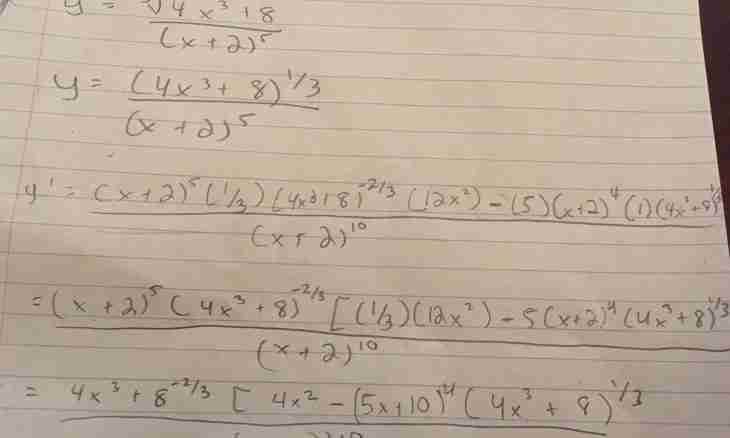Private derivatives are the main components of full differential of function. This concept belongs to each of arguments and assumes calculation proceeding from assumption that other arguments in this case are constants.
Instruction
1. To find full function differential of several variables, it is necessary to calculate a private derivative on each of them. Methods of the decision are similar to finding of derivative function of one argument behind that exception that other variables act as one or several constants composed or multipliers.
2. The principles of definition of a derivative are based on differentiation the simplest and trigonometrical functions: • (x^a)’ = · x^ (a-1); • (a^x)’ = a^x • ln(a); • (sin x)’ = cos x; • (cos x)’ = - sin x; • (tg x)’ = 1/cos² x; • (ctg x)’ = - 1/sin² x; • With’ = 0, With – a constant; • x’ = 1.
3. The derivative of the function containing variables of high degree is determined by Leibniz's formula: f^(n) = Σ C (n) ^k•f^(n-k), where C (n) ^k – binomial coefficients.
4. Review an example: f = 2 · x • at² + 5·y · z^5 + 3·x \\• √z.
5. Define a private derivative on x. At the same time each of composed present in the form functions from x. In this case elements 2 • at², 5·y · z^5 and 3•√z will be constants: f’x = 2•y² + 0 + 6·x· z;
6. When determining a private derivative on y take for constant expressions 2•x, 5•z^5 and 3·x \\• √z: f’y = 4•x • at + 5•z^5 + 0;
7. The private derivative on an argument of z assumes the announcement constants multipliers 5•y, 3·x \and composed 2·x· y²: f’z = 0 + 25·y · z^4 + 3/2·x \/√ z.
8. Private derivatives are used at the solution of the differential equations. At the same time the record ∂f / ∂ x which unlike usual derivative df/dx is perceived as uniform designation, but not as the relation of increment of function and an argument is more widespread. Elements of record cannot be divided.
9. Results of the described example can be written down in the form of full differential of function: df = ∂f / ∂ x · dx + ∂f / ∂ y · du + ∂f / ∂ z · dz = 2 • (y² + 3·x· z) • dx + (4·x· y + 5•z^5) • dy + (25·y · z^4 + (3•x \) / (2•√z)) • dz.
10. To find private derivatives of higher orders, it is necessary having differentiated function the corresponding number of times. For example, the full differential of the second order of the given function will look as follows: d²f = (6•√z) • d²x + (4•x) • d²у + (-3/4·x \/√ z³) • d²z. And differential of the third order here so: d³f = 0•d³x + 0•d³y + (9/8·x \/√ z^5) • d³z, etc.

